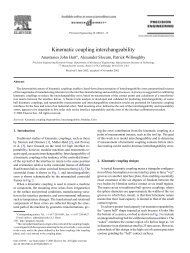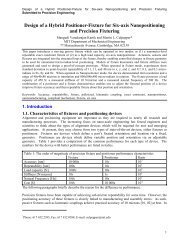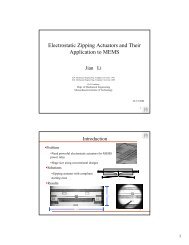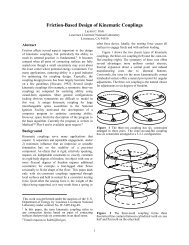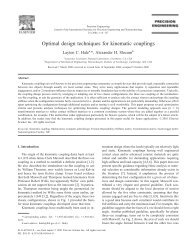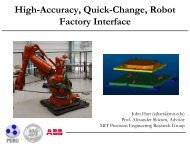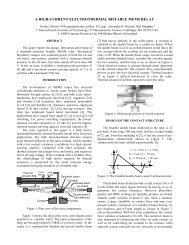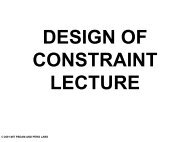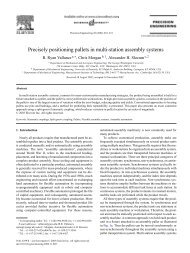- Page 1: Design and Analysis of Kinematic Co
- Page 4 and 5: kinematic couplings. Most powerfull
- Page 6 and 7: 6. Toward Standard, Low-Cost, Intel
- Page 8 and 9: Chapter 44.1 Six-axis industrial ro
- Page 10 and 11: Chapter 66.1 Parameter heirarchy fo
- Page 13 and 14: Chapter 1Introduction1.1 Motivation
- Page 15 and 16: 2. How can the deterministic nature
- Page 17: Chapter 2 is an overview of the bas
- Page 20 and 21: Figure 2.1: Model of three-ball/thr
- Page 22 and 23: For a case study of a simple symmet
- Page 24 and 25: contacting space all the way around
- Page 28 and 29: strength materials) and create a so
- Page 30 and 31: ⎧112 ⎛ ⎛ ⎛ --δ ⎛f n ---
- Page 32 and 33: F 11 sin( α)- sin( β)0 0 0- 1 D -
- Page 34 and 35: contact, and translation of the ass
- Page 36 and 37: K1--2⎛3F⎝------⎞ 1= ⎛2 ⎠
- Page 39 and 40: Chapter 3Interchangeability of Dete
- Page 41 and 42: coordinate frame by a translation a
- Page 43 and 44: in translation error normal to the
- Page 45 and 46: MeasurementErrorT measerrorInterfac
- Page 47 and 48: interfaces can approach their indiv
- Page 49 and 50: Figure 3.5: Canoe ball mount with i
- Page 51 and 52: they directly become the rows of th
- Page 53 and 54: δ xcδ ycε interchange=δ zc(3.19
- Page 55 and 56: 2. p Sn,1 , p Sn,2 , etc. = Relativ
- Page 57 and 58: parameters are directly the points
- Page 59 and 60: nominal thickness, and the magnitud
- Page 61 and 62: y measy measy ballyy ballzyFigure 3
- Page 63 and 64: The angular alignment of the groove
- Page 65 and 66: while the couplings and measurement
- Page 67 and 68: Complexity Example Calibration Proc
- Page 69 and 70: Error Component [units]Valueh tol [
- Page 71 and 72: 0.20Tool Point Error [mm]0.150.100.
- Page 73 and 74: Figure 3.14: Prototype groove base
- Page 75 and 76: Figure 3.17: Interchangeability set
- Page 77 and 78:
0.00450.00400.0035MeasuredAfter Exc
- Page 79 and 80:
3.7.1 Variable DimensionsThe interc
- Page 81 and 82:
This model is used in the next chap
- Page 83 and 84:
appropriate calibration procedures
- Page 87 and 88:
Chapter 4Machine Case Study: Mechan
- Page 89 and 90:
ures empirically cause a per shift
- Page 91 and 92:
4.2 Current Interface Design and Ro
- Page 93 and 94:
4.2.2 Current Robot Calibration Pro
- Page 95 and 96:
ally demanded for continuous path a
- Page 97 and 98:
In the canoe ball case, design a pr
- Page 99 and 100:
unseating, reseating, and measuring
- Page 101 and 102:
Although dynamic tests were not run
- Page 103 and 104:
For the first step, the coupling lo
- Page 105 and 106:
Figure 4.16: Interface plates fitte
- Page 107 and 108:
Figure 4.18: Prototype shouldered c
- Page 109 and 110:
Knowing 50 N-m of torque would be a
- Page 111 and 112:
constraint, then applying a preload
- Page 113 and 114:
4.5 Prototype Repeatability TestsWi
- Page 115 and 116:
Two test procedures were establishe
- Page 117 and 118:
For the basic mounting procedure, s
- Page 119 and 120:
torque was more than sufficient to
- Page 121 and 122:
The measurements of static quasi-ki
- Page 123 and 124:
neighborhood) trial to the outlying
- Page 125 and 126:
Deviation [mm]0.200.150.100.050.00-
- Page 127 and 128:
Figure 4.44: Canoe ball surface aft
- Page 129 and 130:
4.6.1.2 ResultsTable 4.9: Error com
- Page 131 and 132:
the accuracy of the base interface
- Page 133 and 134:
interface produces perfect intercha
- Page 135 and 136:
0.20Tool Point Error [mm]0.180.160.
- Page 137 and 138:
Figure 4.49: Split groove canoe bal
- Page 139 and 140:
Generally, the concept of a determi
- Page 141 and 142:
20 C) and dirt buildup and harsh tr
- Page 143 and 144:
Chapter 5Instrumentation Case Study
- Page 145 and 146:
that many of them may be used simul
- Page 147 and 148:
diameter, with equilaterally triang
- Page 149 and 150:
Figure 5.4: Theorized constant temp
- Page 151 and 152:
Therefore, with the goal to minimiz
- Page 153 and 154:
All heat transfer relations are ref
- Page 155 and 156:
Angular drift of the stack was meas
- Page 157 and 158:
knowledge of the resistance across
- Page 159 and 160:
4. After these six hours of heating
- Page 161 and 162:
5.3.3 Results5.3.3.1 Finite Element
- Page 163 and 164:
Figure 5.15: Axial displacement con
- Page 165 and 166:
0.200.10Tilt Angle [arcsec]0.00-0.1
- Page 167 and 168:
superior in disturbance rejection,
- Page 169 and 170:
1.801.601.40Temperature [C]1.201.00
- Page 171 and 172:
Temperature [C]1.801.601.401.201.00
- Page 173 and 174:
0.2000.150Temperature [C]0.1000.050
- Page 175 and 176:
of heat, the temperature difference
- Page 177 and 178:
0.200 50 100 150 200 250 300 350 40
- Page 179 and 180:
Table 5.3 gives the results of the
- Page 181 and 182:
0.350.3One-Piece5 Segments1-9 Segme
- Page 183 and 184:
copper tube segments. Individual 1W
- Page 185 and 186:
Fixed-base parallel manipulators ca
- Page 187 and 188:
Chapter 6Toward Standard, Low-Cost,
- Page 189 and 190:
The efficiency of the standard mech
- Page 191 and 192:
6.1.2 Building and Using a Web-Base
- Page 193 and 194:
tor, offers similar design guidance
- Page 195 and 196:
other unit can be homogeneous with
- Page 197 and 198:
dcontactRcoupLtRoutRinθFigure 6.4:
- Page 199 and 200:
parallel arrangement of springs for
- Page 201 and 202:
Wireless Close Read ORDirect Entry-
- Page 203 and 204:
matted as XML schemas and broadcast
- Page 205 and 206:
PROCESS FEEDBACKSYSTEMADMINISTRATOR
- Page 207 and 208:
Furthermore, a fourth class of inte
- Page 209 and 210:
For datum point (rather than custom
- Page 211 and 212:
OFFLINECOMPUTERInteractive display
- Page 213 and 214:
Chapter 7ConclusionThis thesis soug
- Page 215 and 216:
Appendix AReferencesChapter 2[1] Sl
- Page 217 and 218:
Appendix BKinematic Coupling Design
- Page 219 and 220:
MLz + FLy*XL - FLx*XL];% Coupling D
- Page 221 and 222:
end% Computation of coupling locati
- Page 223 and 224:
ctthree = Rethree*sqrt((1/Rgrv3)^2+
- Page 225 and 226:
% New ball coordinatesxboneN = xbon
- Page 227 and 228:
four))^2)*sign(Abc*delthree+Abd*del
- Page 229 and 230:
B.2 Contact Force Calculation for T
- Page 231 and 232:
Rpins = 0.5;yo = 0.5;% radius offse
- Page 233 and 234:
f2_torquevector = mut*cross(v_fr2_c
- Page 235 and 236:
n3_torquevector = cross(v_cont3,v3_
- Page 237 and 238:
Appendix CKinematic Exchangeability
- Page 239 and 240:
tol_msys = 0.1; % measurement syste
- Page 241 and 242:
% Nominal groove normal vectorsn11
- Page 243 and 244:
pvr_grooves = randn(3,1).*pt_ps;pvt
- Page 245 and 246:
a21b = -1*sin(th2b)/sqrt(1+tan(thg)
- Page 247 and 248:
32gt = -cos(th3g)/sqrt(1+tan(thga3_
- Page 249 and 250:
% 14 = using offset measurement fea
- Page 251 and 252:
function [errorHTM] = errortransfor
- Page 253 and 254:
% of a three-pin kinematic coupling
- Page 255 and 256:
mag(normal1)*radii(1) + normal1(1)*
- Page 257 and 258:
Appendix DAppended Thermal Stabilit
- Page 259 and 260:
Temperature [C]0.800.700.600.500.40
- Page 261 and 262:
Temperature [C]0.800.700.600.500.40
- Page 263 and 264:
Appendix ERobot Calibration Pose Se




